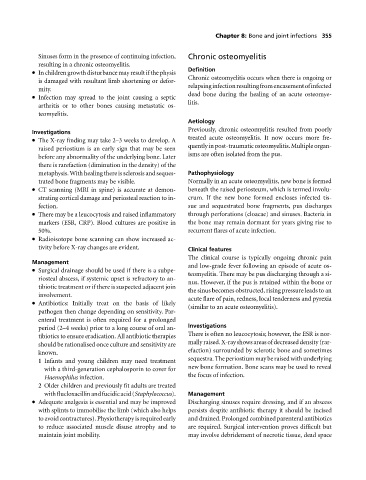Page 359 - Medicine and Surgery
P. 359
P1: KTX
BLUK007-08 BLUK007-Kendall May 12, 2005 19:48 Char Count= 0
Chapter 8: Bone and joint infections 355
Sinuses form in the presence of continuing infection, Chronic osteomyelitis
resulting in a chronic osteomyelitis.
Definition
In children growth disturbance may result if the physis
Chronic osteomyelitis occurs when there is ongoing or
is damaged with resultant limb shortening or defor-
relapsinginfectionresultingfromencasementofinfected
mity.
dead bone during the healing of an acute osteomye-
Infection may spread to the joint causing a septic
litis.
arthritis or to other bones causing metastatic os-
teomyelitis.
Aetiology
Previously, chronic osteomyelitis resulted from poorly
Investigations
treated acute osteomyelitis. It now occurs more fre-
The X-ray finding may take 2–3 weeks to develop. A
quentlyinpost-traumaticosteomyelitis.Multipleorgan-
raised periostium is an early sign that may be seen
isms are often isolated from the pus.
before any abnormality of the underlying bone. Later
there is rarefaction (diminution in the density) of the
metaphysis. With healing there is sclerosis and seques- Pathophysiology
trated bone fragments may be visible. Normally in an acute osteomyelitis, new bone is formed
CT scanning (MRI in spine) is accurate at demon- beneath the raised periosteum, which is termed involu-
strating cortical damage and periosteal reaction to in- crum. If the new bone formed encloses infected tis-
fection. sue and sequestrated bone fragments, pus discharges
There may be a leucocytosis and raised inflammatory through perforations (cloacae) and sinuses. Bacteria in
markers (ESR, CRP). Blood cultures are positive in the bone may remain dormant for years giving rise to
50%. recurrent flares of acute infection.
Radioisotope bone scanning can show increased ac-
tivity before X-ray changes are evident. Clinical features
The clinical course is typically ongoing chronic pain
Management
and low-grade fever following an episode of acute os-
Surgical drainage should be used if there is a subpe-
teomyelitis. There may be pus discharging through a si-
riosteal abscess, if systemic upset is refractory to an-
nus. However, if the pus is retained within the bone or
tibiotic treatment or if there is suspected adjacent join
the sinus becomes obstructed, rising pressure leads to an
involvement.
acute flare of pain, redness, local tenderness and pyrexia
Antibiotics: Initially treat on the basis of likely
(similar to an acute osteomyelitis).
pathogen then change depending on sensitivity. Par-
enteral treatment is often required for a prolonged
period (2–4 weeks) prior to a long course of oral an- Investigations
tibiotics to ensure eradication. All antibiotic therapies There is often no leucocytosis; however, the ESR is nor-
should be rationalised once culture and sensitivity are mallyraised.X-rayshowsareasofdecreaseddensity(rar-
known. efaction) surrounded by sclerotic bone and sometimes
1 Infants and young children may need treatment sequestra.Theperiostiummayberaisedwithunderlying
with a third-generation cephalosporin to cover for new bone formation. Bone scans may be used to reveal
Haemophilus infection. the focus of infection.
2 Older children and previously fit adults are treated
withflucloxacillinandfucidicacid(Staphylococcus). Management
Adequate analgesia is essential and may be improved Discharging sinuses require dressing, and if an abscess
with splints to immobilise the limb (which also helps persists despite antibiotic therapy it should be incised
to avoid contractures). Physiotherapy is required early and drained. Prolonged combined parenteral antibiotics
to reduce associated muscle disuse atrophy and to are required. Surgical intervention proves difficult but
maintain joint mobility. may involve debridement of necrotic tissue, dead space

